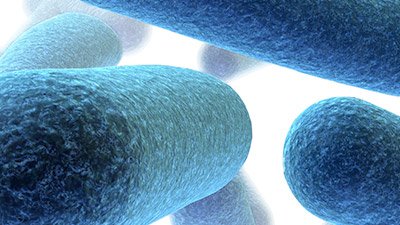
As Opposed to Dead Evolution?
ScienceDaily: “Live Evolution Witnessed In Controlled Environment Of Microbial Predator And Prey” Ooh! Live evolution! Could it really be!?
According to the news, French scientists have been busy watching predator and prey bacteria “evolve” over some 300 generations in a controlled environment—until the prey becomes “resistant.” Does that sound like the story of antibiotic resistance? The scenario is so similar that the news release refers to the predator (actually the bacterium Bdellovibrio bacteriovorus) as a “living antibiotic.”
It all depends on how you define evolution.
The prey in the experiment was Pseudomonas fluorescens. Under starting conditions, the predator is able to penetrate most of the prey and eat it from the inside. However, as the “evolution” takes place, only two forms of the prey survive the predator: the “Wrinkly Spreader morph” and the “Fuzzy Spreader morph.” The former group colonized the top of the liquid medium the bacteria were in, forming a protective biofilm on the surface. The latter group retreated to the bottom of the bottles, where the lowest levels of oxygen are. (The “evolution” took place over 300 generations, with researchers continually agitating, sampling, freezing, and transplanting portions of the liquid medium to emulate natural selection in the wild.)
The predator bacterium “evolved” as well, eventually able to attack the “Fuzzy Spreader” morph—though the release notes that “[w]hat makes prey resistant or predators capable of attacking them again remains poorly understood.”
So, is this evolution? As we have written many times in the past, it all depends on how you define evolution. In the sense that P. fluorescens is changing, yes; in the sense that P. fluorescens could one day become a completely new organism with a more sophisticated genome programming novel capabilities, no.
Instead, this is a perfect example of natural selection acting on what are likely mutations. According to the news release, all P. fluorescens should have been identical as of the first generation. Assuming this was the case, the Wrinkly Spreader and Fuzzy Spreader morphs would likely have been the result of genetic mutations after the first generation that led these two morphs to behave differently—in this case, colonizing different parts of the bottles they lived in.
A simple analogy would be a population of humans in a forest who are being hunted down by Grizzly bears. (For starters, imagine speeding up the reproductive process so that we can observe 300 generations of human and bear population growth—transplanted among different experimental forests—within a few months.) Most humans are, sooner or later, eaten by the bears. However, a few diminutive humans are able to squeeze into tiny caves in the forest that the bears can't reach inside. This small human population survives and is able to thrive once most normal-sized humans have died out.
Scientists haven’t yet sequenced the bacterial genomes.
Does this new population have new genetic information that the earlier humans lacked (such as a new defense structure, sharp claws, superhuman strength, etc.)? No, and if the bears were gone and the “normal” human population were restored, the diminutive population might struggle to survive.
In none of these cases, either with the bacteria or in the fictional human/bear example, are the “evolved” species gaining genetic information or new capabilities. It’s probably the exact opposite of the gain in genetic information that would be required for bacteria to evolve into fish, into reptiles, into mammals, into humans, etc.
The news release even concludes by confirming that scientists haven’t yet sequenced the bacterial genomes. We’re confident that when they do, they will find that the evolved bacteria are not generally more fit than their ancestors, but rather less fit.
For more information:
Remember, if you see a news story that might merit some attention, let us know about it! (Note: if the story originates from the Associated Press, Fox News, MSNBC, the New York Times, or another major national media outlet, we will most likely have already heard about it.) And thanks to all of our readers who have submitted great news tips to us.
(Please note that links will take you directly to the source. Answers in Genesis is not responsible for content on the websites to which we refer. For more information, please see our Privacy Policy.)
Recommended Resources

Answers in Genesis is an apologetics ministry, dedicated to helping Christians defend their faith and proclaim the good news of Jesus Christ.
- Customer Service 800.778.3390
- Available Monday–Friday | 9 AM–5 PM ET
- © 2025 Answers in Genesis





